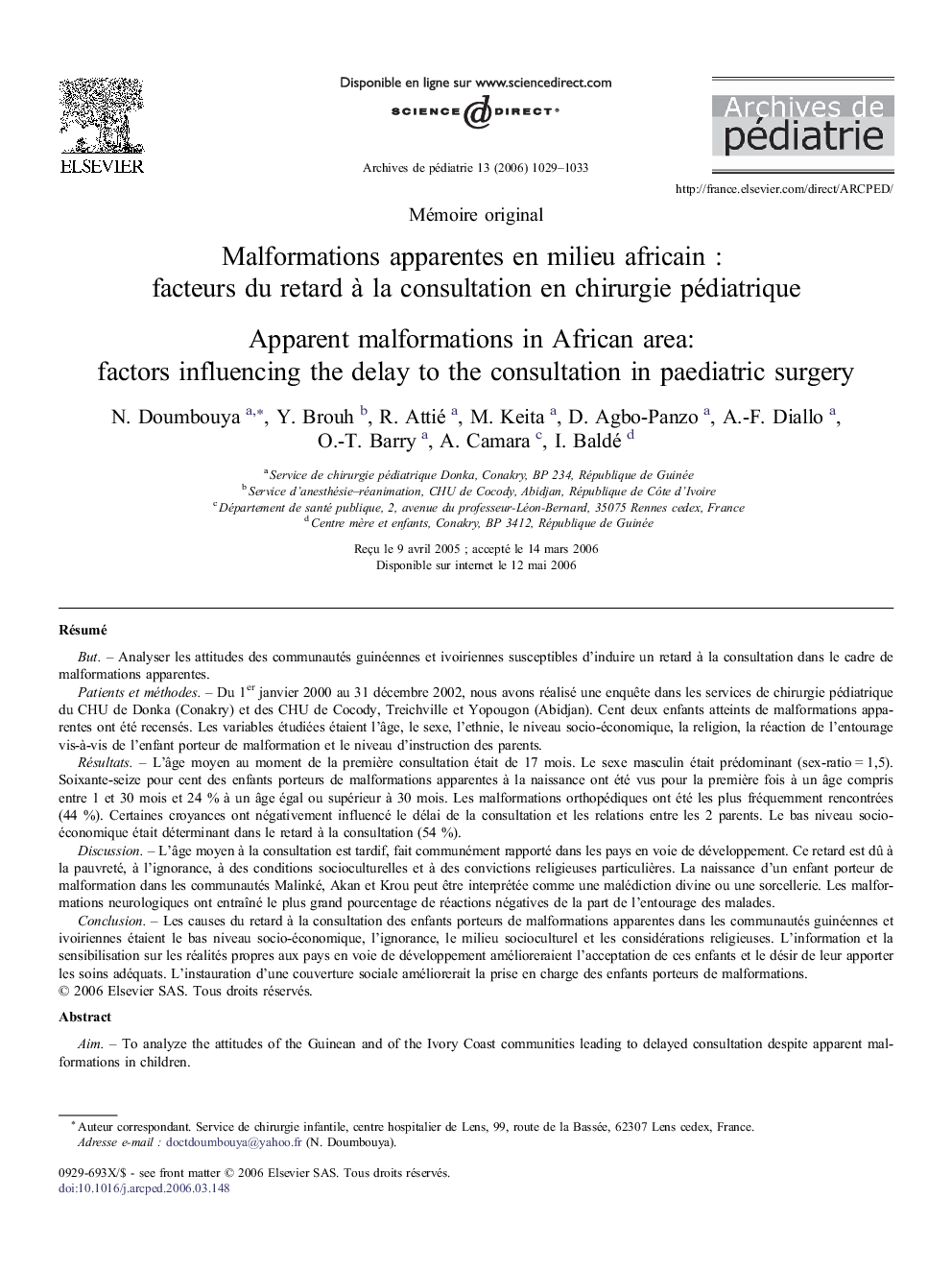| Article ID | Journal | Published Year | Pages | File Type |
|---|---|---|---|---|
| 4149808 | Archives de Pédiatrie | 2006 | 5 Pages |
RésuméButAnalyser les attitudes des communautés guinéennes et ivoiriennes susceptibles d'induire un retard à la consultation dans le cadre de malformations apparentes.Patients et méthodesDu 1er janvier 2000 au 31 décembre 2002, nous avons réalisé une enquête dans les services de chirurgie pédiatrique du CHU de Donka (Conakry) et des CHU de Cocody, Treichville et Yopougon (Abidjan). Cent deux enfants atteints de malformations apparentes ont été recensés. Les variables étudiées étaient l'âge, le sexe, l'ethnie, le niveau socio-économique, la religion, la réaction de l'entourage vis-à-vis de l'enfant porteur de malformation et le niveau d'instruction des parents.RésultatsL'âge moyen au moment de la première consultation était de 17 mois. Le sexe masculin était prédominant (sex-ratio = 1,5). Soixante-seize pour cent des enfants porteurs de malformations apparentes à la naissance ont été vus pour la première fois à un âge compris entre 1 et 30 mois et 24 % à un âge égal ou supérieur à 30 mois. Les malformations orthopédiques ont été les plus fréquemment rencontrées (44 %). Certaines croyances ont négativement influencé le délai de la consultation et les relations entre les 2 parents. Le bas niveau socio-économique était déterminant dans le retard à la consultation (54 %).DiscussionL'âge moyen à la consultation est tardif, fait communément rapporté dans les pays en voie de développement. Ce retard est dû à la pauvreté, à l'ignorance, à des conditions socioculturelles et à des convictions religieuses particulières. La naissance d'un enfant porteur de malformation dans les communautés Malinké, Akan et Krou peut être interprétée comme une malédiction divine ou une sorcellerie. Les malformations neurologiques ont entraîné le plus grand pourcentage de réactions négatives de la part de l'entourage des malades.ConclusionLes causes du retard à la consultation des enfants porteurs de malformations apparentes dans les communautés guinéennes et ivoiriennes étaient le bas niveau socio-économique, l'ignorance, le milieu socioculturel et les considérations religieuses. L'information et la sensibilisation sur les réalités propres aux pays en voie de développement amélioreraient l'acceptation de ces enfants et le désir de leur apporter les soins adéquats. L'instauration d'une couverture sociale améliorerait la prise en charge des enfants porteurs de malformations.
AimTo analyze the attitudes of the Guinean and of the Ivory Coast communities leading to delayed consultation despite apparent malformations in children.Patients and methodsFrom January 1, 2000 to December 31, 2002, we carried out a prospective investigation in the paediatric surgery units of the Donka teaching hospital (Conakry) and Cocody, Treichville and Yopougon (Abidjan) teaching hospital. One hundred and two children affected with apparent malformations were included. The studied variables were: age, sex, ethnos group, religion, socio-economic level and the cultural designs of the families.ResultsSex ratio male/female was 1,5 and the average age at first consultation was 17 months. Seventy-six per cent of the children carrying apparent malformations at birth were seen at an age ranging from 1 to 30 months. Orthopaedic malformations were prominent (44%) and led especially to negative reactions of the entourage of the patients. Some religious beliefs took a part of the delayed consultation and impaired relationships between the 2 parents. The low socio-economic level (54%) was determining in the delayed consultation. The birth of a child with malformation in the malinké, akan krou community could be understood like a parchment from a god or a witchcraft.ConclusionThe contributive factors of the delay to the consultation of the children carrying apparent malformations in the communities Guinean and of the Ivory Coast are poverty, ignorance and some religious beliefs. Education and well understanding of these reasons in developing country should improve the acceptance and taking care of these children as well as the development of medical insurance system.
